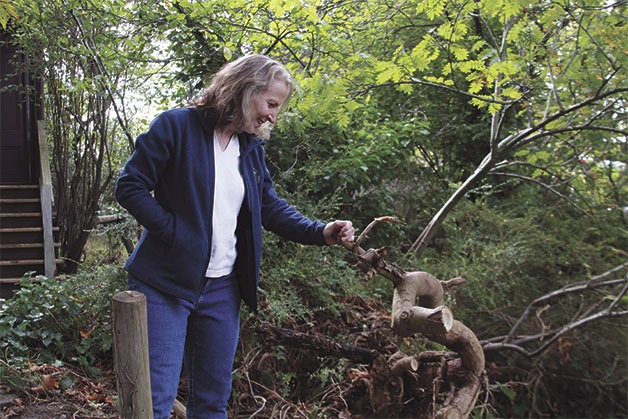A narrow pathway leads to a set of wooden stairs that reveals the entrance to the historic Haller House.
Once a tangle of overgrown shrubs and ivy, the walkway is now more navigable and the grand house less obscured from view from Front Street in Coupeville.
With little plumbing, no wiring, no heat and no renovations done in the 20th century, the house remains in virtually the same state when Major Granville Haller and his wife Henrietta lived there in the late 1800s.
And for historians such as Lynn Hyde, nothing could be more perfect.
Hyde is part of a nonprofit group known as Historic Whidbey that is working to restore the Haller House and use it as a public museum to shed light on Whidbey Island’s significant connection to the mostly unknown territorial period in Washington of the 1860s and ‘70s.
An open house will be held at the house starting at 11:30 a.m. Tuesday, Nov. 11, on Veterans Day to give the public a glimpse of the home built in 1866, create awareness about the preservation group’s efforts to raise money to purchase it and to explain why the structure is important.
Historic Whidbey is currently leasing the house and has an option to buy it in June 2015.
The group wants to restore the two-story house at the corner of Front and Main streets and turn it into a public venue that showcases the house, serves as a museum, offers a public garden area and provides a commercial venture of some kind.
“In this treasure trove of territorial houses, we don’t have anywhere in the (Ebey’s Landing National Historical) Reserve to tell that story,” Hyde said. “By using the Haller House as a history museum, we can use an exhibit to tell the story of territorial Whidbey.”
Coupeville is home to more structures still standing from the territorial era than any other place in Washington, Hyde said. The Haller House could serve as a visible public venue to bring more attention to Coupeville’s place in history and that of the rest of the reserve.

Ebey’s Landing National Historical Reserve was designated a unit the National Parks Service by Congress in 1978 to protect the area’s unique historical landscape in 1978.
Hyde said the “surviving fabric” of the territorial era is part of what prompted Congress and is what separates Coupeville and the reserve from other historic communities.
“Bringing awareness about this period is not just for the locals,” said Hyde, who also serves as an interpretation specialist with the reserve. “It’s for all the visitors who come to visit the reserve. They always ask, ‘Why is the reserve here so special?’
“Part of the enabling legislation is to commemorate the territorial era.”
It was during that era that Haller became a prominent figure in Coupeville, Port Townsend and Seattle.
He was man of significant wealth who built his grand home in Coupeville in 1866 and lived there until 1879 and later a mansion in Seattle.
A successful U.S. Army officer who served in the Civil War and regional wars against Native Americans in the Northwest, Haller came to Coupeville in 1863 after being dismissed from military service for disloyal conduct and sentiments.
He spent 16 years trying to restore his name and eventually succeeded with reinstatement and a promotion to colonel.
“Haller is a fascinating character,” Hyde said.
The home he built in Coupeville was elaborate during that time with its size, high ceilings, grand fire place and special decorative features.
During construction, the house incorporated the Raphael Brunn House that remains connected to the home.
“It was big enough at the time to hold Haller’s ego,” Hyde joked.
Some of the trees that remain in the yard are reminders of Henrietta Haller’s garden.
“It’s a great story for teaching history,” Hyde said. “It’s a great opportunity to tell about our territorial history through this house.”


